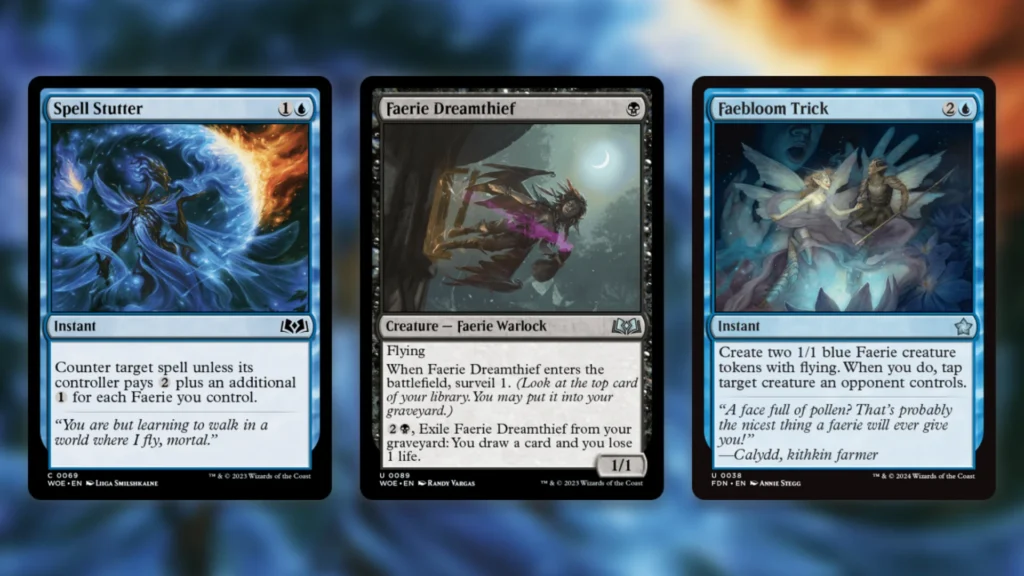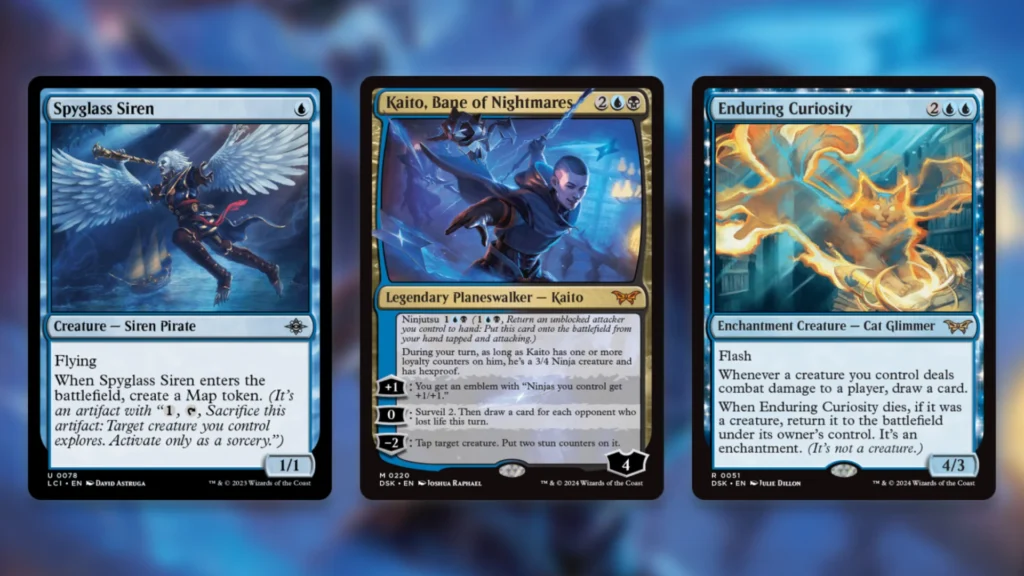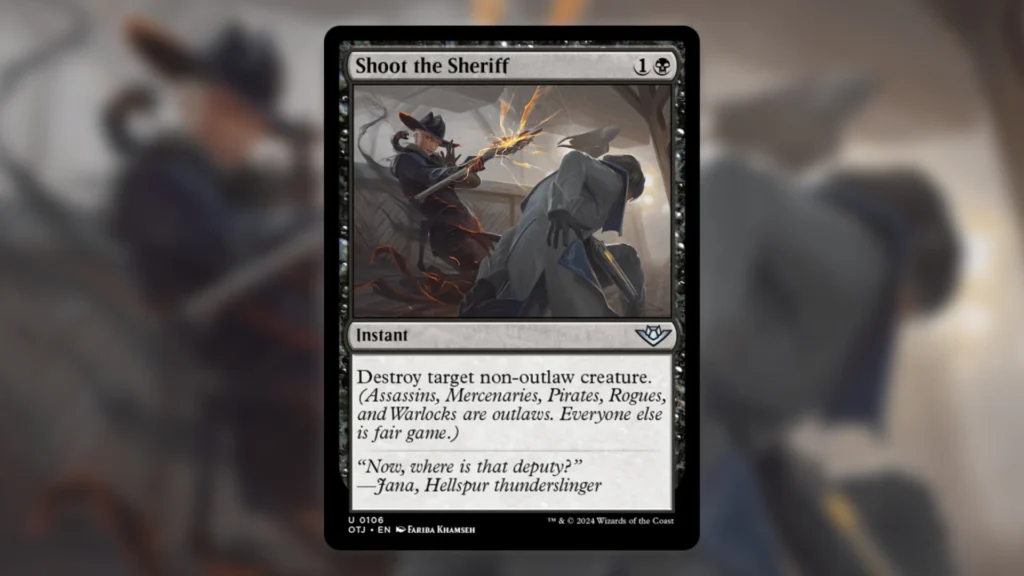It’s a great time to be a Dimir player in Magic: The Gathering right now. Dimir Midrange is one of the most-played decks in Standard, still holding strong even in the face of Izzet Cauldron’s degeneracy. There are just a ton of great cards in the color combo currently: enough to support a deck without any real synergy, even. Turns out Midrange isn’t the only way to play blue/black, mind you. This week, a new Dimir Faeries deck made itself known in MTG Standard.
Typal decks are pretty rare in Standard, and Faeries are especially obscure. There just aren’t that many Faeries, or support cards for them, in the format right now. For Alscec, who piloted Dimir Faeries to a 5-0 finish in yesterday’s MTGO Standard League, this clearly wasn’t a problem. The tools the deck has are obviously potent enough to deliver results. The question now is whether or not they’ll be able to challenge the established Dimir Midrange order.
Dimir Faeries In MTG Standard

For a Typal deck, Dimir Faeries is actually fairly light on its titular creature type. In fact, there are only nine total Faerie cards in the entire list. When you compare that to the eight Faerie support cards it includes, you get a very unusual ratio.
Said Faeries come in the form of Faerie Dreamthief, Faebloom Trick, and Soulstone Sanctuary. Dreamthief is an Eldraine classic: a 1/1 Flier for one that smooths out your draws with Surveil, then exiles itself from the ‘yard later for some extra card draw. Faerie type line aside, this is just a generically good one drop. The fact that it enables your other synergies here is just icing on the cake.
Faebloom Trick and Soulstone Sanctuary are more recent additions, from last year’s Foundations. Trick gives you two Faeries and taps down an opposing creature for three mana, at instant speed. Sanctuary is mostly just a colorless land, but it can become a 3/3 Faerie for four mana at instant speed. This is a deck that loves holding up mana, and these cards give you great extra options while doing so.
With the Faeries themselves out of the way, let’s get to the reasons why the deck is playing them. Faerie Fencing and Spell Stutter are two powerful payoffs, both of which get really good if you have a Faerie in play. Fencing is a reasonable scaling removal spell by itself, but with a Faerie out it becomes a -3/-3 for one mana.
Spell Stutter gets less of a glow-up from your Faeries, but it’s still a very solid card. In the early to mid game, this is essentially better Disdainful Stroke, and it can stay relevant later with even just one Faebloom Trick.
Something Borrowed, Something Blue

The above cards form the ‘Faerie’ part of Dimir Faeries, but the rest will be more familiar to MTG Standard players. The deck also incorporates a lot of the classic Dimir Midrange pieces, which actually synergize quite nicely with the Faerie package.
The big hitters here are Kaito, Bane of Nightmares and Enduring Curiosity. These are some of the best pound-for-pound cards in Standard right now, and they’re especially good here. Both really benefit from you having cheap evasive creatures. Kaito can come down via Ninjutsu if you do, and Curiosity can draw you extra cards. Since all your Faeries are 1/1 Fliers, this is a match made in heaven.
While it isn’t a Faerie type-wise, Spyglass Siren very much feels like an honorary Faerie in this list. It gives you another enabler for your four-drops, and it gives you a Map, which lets you fix your draws. Classic Dimir Midrange loves this card, and it’s just as good here.
In a similar vein, Alscec also runs a lone copy of Mockingbird here. This is a great way to put an extra evasive body on the board early, while also offering more potential later on. A lot of the time, this will simply copy a Faerie Dreamthief or Faebloom Trick token to boost your Faerie support cards, but later you can have it enter as Enduring Curiosity for a big draw boost.
Rounding things out, Floodpits Drowner is another Standard Dimir staple. While it isn’t evasive itself, it does tap down an opposing creature, which is often comparable. It also has Flash, which means you can hold it up alongside Spell Stutter. Paired with a full playset of Shoot the Sheriff, the deck has a lot of ways to keep the path clear for attacks.
A Shot At The Throne?

Overall, Dimir Faeries is an interesting addition to MTG Standard. It’s also incredibly new: according to MTGGoldfish, only Alscec has had real results with the deck since July 31st. This makes the deck just over a week old. Unfortunately, being so young means Dimir Faeries could easily just be a flash in the pan, and not a real contender in the Standard metagame.
Given how much DNA it shares with Dimir Midrange, that’ll be the biggest obstacle to this deck’s success. Players need a reason to run Faeries over Midrange, otherwise it’ll just keep dominating like it has for the past month. Thankfully, Faeries offers some pretty considerable advantages.
Chief among these is the deck’s more aggressive edge. While Midrange can get out early with a Spyglass Siren or the odd Cecil, Dreamthief gives Faeries more consistent turn one plays. Faerie Fencing and Spell Stutter are also more efficient interaction spells than those Midrange is using. Tragic Trajectory is nice for sure, but sorcery speed really hurts.
Faeries definitely wins out in the early game, but it does suffer later. Midrange can generate more value with cards like Preacher of the Schism, which can then put the game out of reach. For that reason, Faeries is best played as a kind of Aggro/Midrange hybrid, aiming to close out the game before things go long. Doing so makes Spell Stutter much better, too.
Right now, the future of Dimir Faeries is up in the air. With a new Lorwyn set coming in January, however, we could see a lot more support for this strategy soon enough.
Stick with us here at mtgrocks.com: the best site for Magic: The Gathering coverage!
